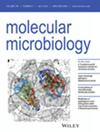权力二人组:核相关蛋白和小非编码rna之间的相互作用如何协调细胞调节交响乐
IF 2.6
2区 生物学
Q3 BIOCHEMISTRY & MOLECULAR BIOLOGY
引用次数: 0
摘要
在细菌中,基因表达的调控涉及复杂的网络,整合了转录和转录后机制。在转录水平上,核相关蛋白(nap)如H-NS、HU、Lrp、IHF、Fis和Hfq是关键的参与者,因为它们不仅紧密结合细菌DNA,而且还调节转录。另一方面,已知小的非编码rna (sRNAs)通过与靶mRNA的碱基配对影响细菌基因转录后的表达,但它们也可能参与类核凝聚。有趣的是,某些nap也会影响sRNAs的功能,相反,sRNAs本身可以调节nap的活性,形成一个复杂的双向调节网络。在这里,我们总结了目前对主要nap的了解,重点是Hfq的具体作用。本文还讨论了sRNAs对nap的调控、nap对sRNAs的调控以及sRNAs在类核结构中的作用。这篇综述的重点是nap和srna之间的串扰,试图了解这种相互作用是如何协调细胞功能的。本文章由计算机程序翻译,如有差异,请以英文原文为准。

The Power Duo: How the Interplay Between Nucleoid-Associated Proteins and Small Noncoding RNAs Orchestrates the Cellular Regulatory Symphony
In bacteria, the regulation of gene expression involves complex networks that integrate both transcriptional and posttranscriptional mechanisms. At the transcriptional level, nucleoid-associated proteins (NAPs) such as H-NS, HU, Lrp, IHF, Fis and Hfq are key players as they not only compact bacterial DNA but also regulate transcription. Small noncoding RNAs (sRNAs), on the other hand, are known to affect bacterial gene expression posttranscriptionally by base pairing with the target mRNA, but they can also be involved in nucleoid condensation. Interestingly, certain NAPs also influence the function of sRNAs and, conversely, sRNAs themselves can modulate the activity of NAPs, creating a complex bidirectional regulatory network. Here, we summarise the current knowledge of the major NAPs, focusing on the specific role of Hfq. Examples of the regulation of NAPs by sRNAs, the regulation of sRNAs by NAPs and the role of sRNAs in nucleoid structuring are also discussed. This review focuses on the cross-talk between NAPs and sRNAs in an attempt to understand how this interplay works to orchestrate the functioning of the cell.
求助全文
通过发布文献求助,成功后即可免费获取论文全文。
去求助
来源期刊

Molecular Microbiology
生物-生化与分子生物学
CiteScore
7.20
自引率
5.60%
发文量
132
审稿时长
1.7 months
期刊介绍:
Molecular Microbiology, the leading primary journal in the microbial sciences, publishes molecular studies of Bacteria, Archaea, eukaryotic microorganisms, and their viruses.
Research papers should lead to a deeper understanding of the molecular principles underlying basic physiological processes or mechanisms. Appropriate topics include gene expression and regulation, pathogenicity and virulence, physiology and metabolism, synthesis of macromolecules (proteins, nucleic acids, lipids, polysaccharides, etc), cell biology and subcellular organization, membrane biogenesis and function, traffic and transport, cell-cell communication and signalling pathways, evolution and gene transfer. Articles focused on host responses (cellular or immunological) to pathogens or on microbial ecology should be directed to our sister journals Cellular Microbiology and Environmental Microbiology, respectively.
 求助内容:
求助内容: 应助结果提醒方式:
应助结果提醒方式:


